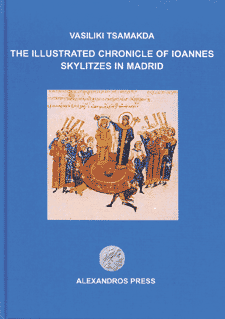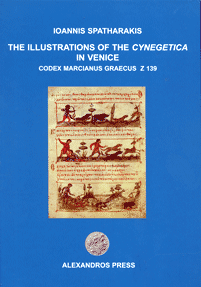Byzantine Illustrated Manuscripts
Illustrated manuscripts constitute an important source for Byzantine art, owing to the number of examples surviving across time and the great loss of monumental painting from Constantinople, the seat of the court and center of patronage from the 9th century onward. The history of the Byzantine Empire, more than one thousand years long, is divided into periods that have the benefits and drawbacks of any such divisions of historical epochs. The first period begins with Constantine (reigned 324–337) ruling a still-substantial Roman Empire, and it ends with the liquidation of iconoclasm in 843; by then, the state had been vastly reduced in size, having lost North Africa, the eastern provinces, and all of Italy but the southern part, and was fending off Slav incursions into Greece and the Arabs into Asia Minor. The second period, the Middle Byzantine, sees both a strong economic and a military revival; its end comes with the Latin Conquest and occupation of Constantinople in 1204, though works of the 13th century are often, though uneasily, included in this period. The third and last period begins with the restoration of Byzantine rule under the Palaiologan emperors in 1261 and ceases with the fall of Constantinople to the Ottoman Turks in 1453. Only a handful of illustrated books survive from the first period. It may be that books with pictures were not produced in great number, or at least great enough to ensure that a representative sample survived the ravages of time; also working against early manuscripts, whether illuminated or not, is the revolution that took place in the generations following the end of iconoclasm, when minuscule writing came to replace uncial, quickly superannuating books copied in the old and labor-intensive script. During the late 9th and 10th centuries, manuscripts with elegant ornament and miniatures begin to reappear, and the 11th and 12th centuries witnessed a dramatic increase both in the types and number of books illustrated. Palaiologan illustration reflects the depth of cultural disruption caused by the Latin Conquest, but it can hardly be dismissed as merely a revival, whether that word denotes art making in general or refers specifically to the handful of works that copy or adapt models from the 10th century. Palaiologan illuminators, like monumental painters, created dramatic and emotionally affecting works offering a degree of naturalism unknown in earlier Byzantine art. In doing so they laid the foundation for later painting in Greece, the Balkans, and Russia.
Survey Books
Manuscript illumination is covered in all surveys by the reproduction of a handful of “masterpieces,” such as the Vienna Genesis, Paris Psalter, Joshua Roll, and Theodore Psalter. They are then discussed with ivory carvings and deluxe metalwork objects, a combination that is problematic on two counts. The first is the skewed impression of Byzantine material culture inevitably produced. The second is that ivories survive in limited number and from a narrow period of time and that costly metalwork objects are rare, but illuminated manuscripts survive in the thousands; their range and use can hardly be grasped by a dozen exceptional works. Beckwith 1968, a brief handbook, is a chronological survey of sculpture and painting from the 4th century through the 15th. Mathews 1998treats all media, including architecture, in a survey that is thematic rather than strictly chronological. Volbach and Lafontaine-Dosogne 1968 covers all media and is especially rich in the treatment of the lands bordering the Byzantine Empire, which are not an issue here. Lazarev 1967 treats the period from Constantine to the fall of Constantinople in 1453 and limits its discussion to painting, which is the author’s strength, as is the rich documentation he compiled. This text is nearly five hundred pages long, supported by 576 illustrations. Lowden 1997 is a concise handbook of Byzantine art from the early Christian period to the fall of Constantinople.
"Byzantine Manuscript Illumination". In obo in Medieval Studies, (accessed 27 Aug. 2019).
Books on Manuscripts
-
A Companion to Byzantine Illustrated Manuscripts by
Call Number: ND2930 .C66 2017ISBN: 9789004343184Publication Date: 2017-06-21 -
 The Treasures of Mount Athos : illuminated manuscripts, miniatures-headpieces-initial letters
by
Call Number: ND3156.A83 P3713 1974
The Treasures of Mount Athos : illuminated manuscripts, miniatures-headpieces-initial letters
by
Call Number: ND3156.A83 P3713 1974 -
Illuminated Prophet Books by
Call Number: ND2930 .L69 1988ISBN: 0271006048Publication Date: 1990-10-01 -
Imagining the Byzantine Past by
Call Number: D13.5.B95 B64 2015ISBN: 9781107085817Publication Date: 2015-07-09 -
 Byzantine illuminated manuscripts of the Patriarchate of Jerusalem
by
Call Number: ND2930 .V63 2002ISBN: 9608716012
Byzantine illuminated manuscripts of the Patriarchate of Jerusalem
by
Call Number: ND2930 .V63 2002ISBN: 9608716012 -
-
 Patronage in Thirteenth-Century Constantinople. An Atelier of Late Byzantine Book Illumination and Calligraphy
by
Call Number: ND2930 .B835 1978ISBN: 0884020762Publication Date: 1978-01-01
Patronage in Thirteenth-Century Constantinople. An Atelier of Late Byzantine Book Illumination and Calligraphy
by
Call Number: ND2930 .B835 1978ISBN: 0884020762Publication Date: 1978-01-01 -
 Studies in Classical and Byzantine Manuscript Illumination
by
Call Number: ND2930 .W43 1971ISBN: 0226892468Publication Date: 1995-06-14
Studies in Classical and Byzantine Manuscript Illumination
by
Call Number: ND2930 .W43 1971ISBN: 0226892468Publication Date: 1995-06-14 -
Towards the Macedonian renaissance; Macedonian text-books of the nineteenth century by
Call Number: LB2853.M3 K613 -
 Byzantine illumination, 1150-1250 : the study of a provincial tradition
by
Call Number: ND2930 .C37 1987ISBN: 0226688631
Byzantine illumination, 1150-1250 : the study of a provincial tradition
by
Call Number: ND2930 .C37 1987ISBN: 0226688631 -
 Byzantine illumination
Call Number: ND2930 .B9 1952
Byzantine illumination
Call Number: ND2930 .B9 1952 -
 An Illuminated Byzantine Gospel book , National Gallery of Victoria, Melbourne
by
Call Number: ND2930 .B83 1961
An Illuminated Byzantine Gospel book , National Gallery of Victoria, Melbourne
by
Call Number: ND2930 .B83 1961 -
 The illustrated chronicle of Ioannes Skylitzes in Madrid : with 604 illustrations
by
Call Number: ND3399.J6 T83 2002ISBN: 9080647624
The illustrated chronicle of Ioannes Skylitzes in Madrid : with 604 illustrations
by
Call Number: ND3399.J6 T83 2002ISBN: 9080647624 -
 The illustrations of the Cynegetica in Venice : codex Marcianus Graecus Z 139
by
Call Number: ND2930 .S64 2004ISBN: 9789080647640
The illustrations of the Cynegetica in Venice : codex Marcianus Graecus Z 139
by
Call Number: ND2930 .S64 2004ISBN: 9789080647640 -
 The Byzantine Octateuchs
by
Call Number: ND3356 .I44 1999ISBN: 0691007225Publication Date: 1999-07-26
The Byzantine Octateuchs
by
Call Number: ND3356 .I44 1999ISBN: 0691007225Publication Date: 1999-07-26 -
-
Literacy, Education and Manuscript Transmission in Byzantium and Beyond by
Call Number: P211.3.B99 L57 2002ISBN: 9004120963Publication Date: 2002-09-27 -
Byzantium in the mirror : the Message of Skylitzes Matritensis and Hagia Sophia in Constantinople by
Call Number: DF553 .P55 2005ISBN: 1841716804Publication Date: 2005-02-15



